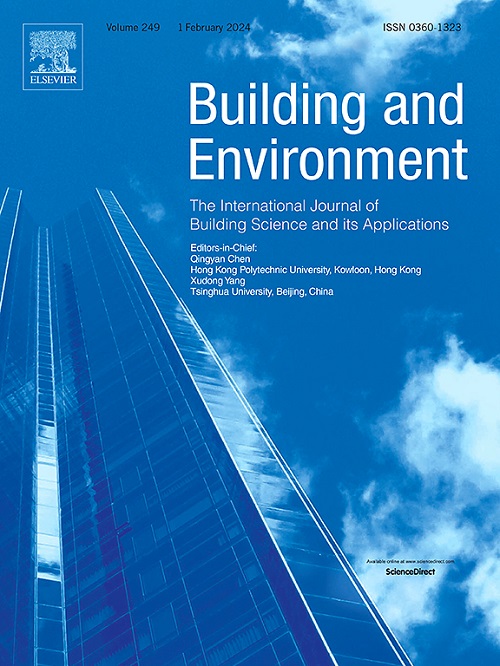Resuspension of inhalable particles from clothing: A manikin-based chamber study
IF 7.1
1区 工程技术
Q1 CONSTRUCTION & BUILDING TECHNOLOGY
引用次数: 0
Abstract
Clothing plays a significant role in facilitating inhalation exposure to particulate matter (PM). Nevertheless, there is a lack of studies investigating PM resuspension from clothing. This study aims to quantify size-resolved PM resuspension rate (RR) from clothing while exploring the effects of factors influencing this process. In a controlled chamber, we deposited Arizona Test Dust on a seated and clothed thermal manikin. The seated manikin was then placed in a resuspension chamber to perform arm movements using a consistent test mechanism. We evaluated the size-resolved resuspension rates in the diameter range 0.3–10 μm as a function of long-sleeve clothing type (cotton shirts vs. polyacrylic sweaters), relative humidity (RH) (35 vs. 70 %), dust loading (204 vs. 321 mg/m2), and movement intensity (0.25, 0.5, and 0.75 Hz). The short-term PM10 concentration in the breathing zone was 1.25 times higher than in the bulk air during resuspension. The size-dependent RR varied between 0.01 h−1 and 0.06 h−1. Higher RR was associated with higher movement intensity and dust loading on clothing, while a small dependence was found on clothing type and RH. The results offer a valuable dataset for enhancing current inhalation exposure models related to indoor aerosols and for developing targeted interventions to reduce exposure to particles associated with clothing.
衣服上可吸入颗粒的再悬浮:基于人体模型的试验室研究
服装在促进吸入颗粒物(PM)方面发挥着重要作用。然而,目前还缺乏对衣物中可吸入颗粒物再悬浮的研究。本研究旨在量化衣服上颗粒物再悬浮率(RR)的粒度分辨,同时探索影响这一过程的因素的作用。在一个受控室内,我们将亚利桑那测试粉尘沉积在一个坐着并穿着衣服的热力人体模型上。然后将坐着的人体模型放入再悬浮室,使用一致的测试机制进行手臂运动。我们评估了直径范围为 0.3-10 μm 的粒度分辨再悬浮率与长袖衣服类型(棉衬衫与腈纶毛衣)、相对湿度(RH)(35% 与 70%)、粉尘负荷(204 mg/m2 与 321 mg/m2)和运动强度(0.25、0.5 和 0.75 Hz)的函数关系。在再悬浮过程中,呼吸区的短期 PM10 浓度是散装空气的 1.25 倍。与尺寸相关的RR在0.01 h-1和0.06 h-1之间变化。较高的 RR 与较高的运动强度和衣物上的粉尘负荷有关,而与衣物类型和相对湿度的关系不大。研究结果提供了一个宝贵的数据集,可用于改进目前与室内气溶胶相关的吸入暴露模型,并制定有针对性的干预措施,以减少与衣物相关的微粒暴露。
本文章由计算机程序翻译,如有差异,请以英文原文为准。
求助全文
约1分钟内获得全文
求助全文
来源期刊

Building and Environment
工程技术-工程:环境
CiteScore
12.50
自引率
23.00%
发文量
1130
审稿时长
27 days
期刊介绍:
Building and Environment, an international journal, is dedicated to publishing original research papers, comprehensive review articles, editorials, and short communications in the fields of building science, urban physics, and human interaction with the indoor and outdoor built environment. The journal emphasizes innovative technologies and knowledge verified through measurement and analysis. It covers environmental performance across various spatial scales, from cities and communities to buildings and systems, fostering collaborative, multi-disciplinary research with broader significance.
 求助内容:
求助内容: 应助结果提醒方式:
应助结果提醒方式:


